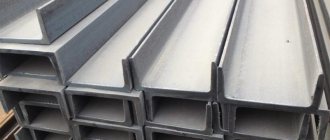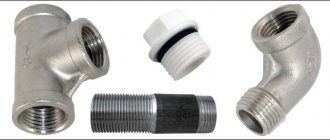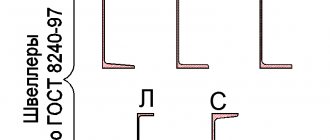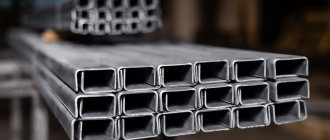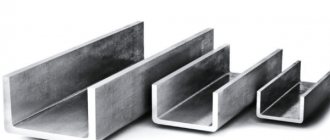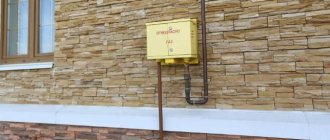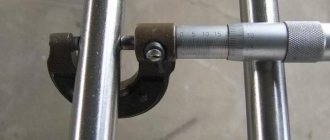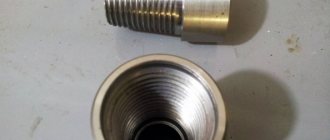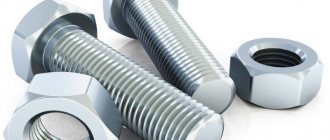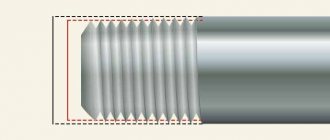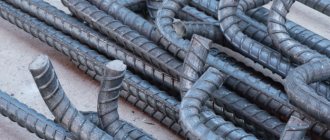Channel - hot-rolled shaped steel with a box-shaped U-shaped section intended for steel structures, as well as structures with welded and other connections. Channels are manufactured with lengths from 2 to 12 m, by agreement between the consumer and the manufacturer - lengths over 12 m. The weight of the channel varies from 4.79-61.5 kg per linear meter.
The geometric characteristics of the channel section are determined by its number, which corresponds to the height of the channel wall (in centimeters). The channel is used in:
- Powerful rod structures Bridges
- Long span trusses
The geometric characteristics of the channel section are determined by its number, which corresponds to the height of the channel wall (in centimeters). The range includes channels with and without sloped internal edges of the shelves. The slope of the internal edges of the shelves makes design difficult.
The range also includes channels with parallel flange edges, the cross-section of which has the best design characteristics. Such channels are more constructive, since the parallel edges simplify bolting to the shelves.
If it is impossible to use a channel in building structures, you can resort to replacing the channel with an I-beam, or go to another analogue of the profile.
Channels are used in powerful rod structures (places, long-span trusses, etc.), as well as in columns, ties and roof purlins.
Channel
What is a channel
A channel is a metal beam with a U-shaped cross-section. The main method of its production is shaped metal. It is carried out using two technologies, so the assortment consists of two large groups:
- hot-rolled elements - GOST 8240-97;
- bent - according to standard 8278-83.
The hot-rolled profile has high strength levels and is resistant to mechanical deformation and bending. Therefore, this category is used in the construction of critical and load-bearing parts of the building.
Bend creates less strong channels, so they are not used as support. But their other features are no worse than the hot-rolled version, and their low weight and economical price can be very beneficial in practice.
These are not the only differences between the two methods. When choosing a part for a specific purpose, you need to take into account its parameters, raw materials for manufacturing, and type of design.
GOST - basic provisions
The geometric characteristics of the channel section are determined by its number, which corresponds to the height of the channel wall (in centimeters). The channel is used in:
- Powerful rod structures Bridges
- Long span trusses
The products are divided into the following series:
- U - channel with shelves, internal edges at an angle,
- C – special, edges with a slope,
- P - the edges of the shelves are parallel,
- E – economical, parallel edges,
- L – light, parallel.
For the drawings and all tables below, the following conventions apply:
Channel dimensions
Hot-rolled hot-rolled steel channels are rolled products with a U- or U-shaped section. Hot-rolled channels are divided into 3 types: hot-rolled channel with a slope of internal flanges, with parallel edges of the flanges, and cold-rolled bent channel. Hot-rolled channel is produced in two types of accuracy: increased accuracy-B and normal accuracy-B.
Types and brands of channels depend on the grade of steel from which they are made, which determines their purpose and dimensions. Channels are made with lengths from 4 to 12 m and heights from 5 to 40 mm.
Channels are widely used in the construction of structures, as well as as frames and partitions, since their size allows the creation of structures of various types.
- Channels made of carbon and low-alloy steel. designation P - with parallel shelves and designation U - with slanted internal edges, manufactured in accordance with GOST 8240.
- Channels special for carriage building. designation B - for carriage building they are manufactured in accordance with GOST 5267.
- Channels special for tractors. designation T - for tractors manufactured according to GOST 5420
Lengths
The channel according to GOST 8240-97 is produced in lengths from 2 to 12 meters. If it is necessary to obtain longer products, they are additionally agreed with the manufacturer.
Channel lengths are divided into:
- Measured - a specific value specified in advance,
- Unmeasured - any length that complies with GOST, or is not less than that previously specified,
- Bound by immeasurable limits,
- Multiple of measured - subject to indication of measure and multiplicity,
- Measured with an unmeasured part - the unmeasured part should not exceed 5% of the total mass of the batch,
- A multiple of a dimensional part with a non-dimensional part – similar to the previous point.
Product form and tolerances
Hot-rolled steel channel according to GOST 8240-97 is produced in the following forms.
Deviations in a number of parameters are allowed. Their values are set in the table:
Add-ons
- There is no control of deviations in parameter s for the P and U series.
- The ƒ parameter for the L series should not exceed 0.15*s.
- This parameter is measured according to the above figure.
- Deviations of the parameter t in the positive direction are limited by the maximum error in mass.
Channel parameters accuracy 8240-
Skewed shelves
According to the shelf skew value ∆ (∆'), measured as shown in the figure above, the products are divided into three accuracy categories. The values allowed by GOST are shown in the following table:
Length
Deviations are regulated exclusively for measured and multiple lengths. Their values should be no more than:
- 40 millimeters for a 2-8 meter channel,
- (40+5*(L-8)) millimeters, but not more than 100 millimeters if the length of the product exceeds 8 meters. In this case, the variable L is an indicator of the length of the channel, expressed in meters.
Blunting corners
There are established requirements for errors in blunting angles between the wall and the shelves. For channels up to No. 20, the error value is taken to be 2.5 millimeters, for subsequent numbers - 3.5.
Additional Standards
For the production of rolled metal, including channels, according to GOST 8240-97, additional documents are required that establish the values of the characteristics and technical conditions.
As we have already noted, the channels of this GOST are extremely widespread, therefore, in addition to them, it is necessary to use additional standards:
- GOST 535-2005 – for products made of standard carbon steel.
- GOST 27772 – for rolled metal building structures.
- GOST 19281 – for high-strength products made of unalloyed and low-alloy steels.
- GOST 6713-91 and R 55374 - for channels used in the construction of bridges.
- GOST 5521-93 and R 52927-2008 – for rolled metal used for marine and river structures.
Classification of channels
| No. | Name of channels | Description |
| 1 | Rolled according to GOST 8240-97, DSTU 3436-96 | |
| Steel channel | ||
| 1.1 | Channel. Series U | Channel with a slope of the internal edges of the shelves. Series U. |
| 1.2 | Channel. Series P | Channel with parallel flange edges - P series. |
| 1.3 | Channel. Series E | Economical channel with parallel flange edges - E series. |
| 1.4 | Channel. Series L | Light channel with parallel flange edges - L series. |
| 1.5 | Channel. Series C | Channel with a slope of the internal edges of the shelves - series C. |
| Channel according to the manufacturer's specifications | ||
| 1.6 | Channel according to specifications | |
| Special channel | ||
| 1.7 | Channel. Series C | Channel with a slope of the internal edges of the shelves - series C. |
| Special channel for tractors and carriage building | ||
| 1.8 | Channel | Special channel for tractors and carriage building |
| 2 | Bent | |
| 2.1 | Channel according to GOST 8278-83 | Channel. Bent equal flange |
| 2.2 | Channel according to GOST 8281-80 | Channel. Bent unequal |
Marking and designation of channel in accordance with GOST 8240
The height of the channel profile is approximately 1.5-3.5 times greater than the width. The shape of its cross-section provides it with high levels of rigidity.
Area of use
We have already mentioned the use of channels in different types of construction. Their main task is to strengthen concrete structures, increase the strength and service life of the building. In addition, channels are used to reinforce power lines, bridges, industrial buildings, and structures.
The catalog contains perforated products. They are equipped with special holes necessary for the rapid installation of structures without electric welding. Also, between the channel shelves there may be pipes for supplying utilities and cable lines.
Aluminum channels are relevant for light parts of a building, such as internal partitions, showcases, and shelving.
Channel assortment: ratio of characteristics
The construction of load-bearing structures involves the use of reliable materials. It is to this list that U-shaped steel channels belong. In the manufacture of profiles, various technologies are used and different types of steel are used. The material is classified according to several characteristics, and their relationship determines such a thing as the assortment of channels. What is a channel , scope of application, assortment characteristics and compliance of channels with GOST is discussed in this article. Channel characteristics: how to choose a suitable profile (read more)
Channels are most widely used in construction, manufacturing and automotive industries.
Geometric indicators
The state standard regulates all sizes of rolled metal products, according to production technology. The main parameters are:
- thickness, wall height;
- rolling length;
- internal corner radius;
- shelf curvature radius;
- thickness, shelf width.
There is also a distribution according to the level of rolling accuracy:
- marking “A” - high accuracy;
- "B" - increased;
- "B" is normal.
Marking
The channel is marked using letters and numbers:
- P - channel grade with parallel arrangement of shelves relative to each other.
- Y – indicates a building material with shelves located at an angle.
- L – designation of a lightweight version with parallel shelves.
- C – products for special purposes.
- E - economical design options.
When decoding, you should take into account the numbers that precede the letter. They are designed to determine the distance between the side parts.
In the drawing and in other technical documentation you can find additional letters in the markings. They are intended to indicate accuracy:
- A – tall.
- B – increased.
- B – normal.
Foreign manufacturers may apply other standards for labeling the building material in question.
At the time of manufacture, the raw materials are divided into several blanks, the length of which can range from 4 to 12 meters in length. After this, division is carried out into smaller pieces of measured, multiple measured or unmeasured lengths. Manufacturing may require varying degrees of precision.
Source
What sizes are there?
The dimensions of our products are varied, they are determined by the manufacturer and production technology. Typically used standard sizes:
- Element height. This is the name of the gap between parallel shelves, measured in millimeters. This parameter is in the range of 50-400 mm.
- The width of the shelf is the distance from the outer corner of the part to the end of the parallel-installed edges. Sizes of 32-115 mm are allowed here.
- Beam thickness. This indicator depends on the category, it can be 4.4 – 8 mm.
- Shelf thickness. According to the product labeling, it is in the range of 7-13.5 mm.
A standard channel is no longer than 12 m. Note that there are elements on the market with a higher value, but they are usually made to order.
Tables of channel sizes in accordance with GOST
A steel channel is a fairly popular rolled metal product made from different types of steel. The term itself is of German origin. The main distinguishing feature of the profile is the U-shaped cross-section of the product.
Special equipment is used for the manufacture of channels. Depending on the production method, hot-rolled or bent profiles are distinguished. According to the shape of the edges of the shelves, they can be parallel or have a certain slope inside. The classification is also based on a numerical value in the form of a number next to the corresponding marking. The numbers indicate the size, which is determined by the distance between the edges of the shelves on the outside.
The production of channels, like other rolled metal products, is regulated by the relevant GOST, which clearly states the basic requirements for a particular type of profile. All data is clearly presented in tables. For example, the regulatory document “Hot-rolled steel channels. Assortment" (GOST 8240 97) contains 7 such expanded tables.
Using the corresponding tabular data, you can determine the quality of the product by correlating its actual dimensions with those described in GOST. Ideally, the indicators should completely match, although sometimes metal products are made to order. Individual profiles are produced in small batches - for a specific project. The prices of custom-made channels differ from the cost of mass-produced products.
The standard height of the channels ranges from 50 to 400 mm, the width of the shelves - from 32 to 115 mm. The permissible error (compared to the specified standard dimensions) may be a maximum of 3 mm. The measured length of the channels corresponds to an indicator from 4 to 13 m.
Weight of channels, their markings and symbols
To designate different types of channels, special markings are used. The letter indicates the type of profile, characterizing the structural features and arrangement of the edges:
- “P” – indicates parallelism;
- “U” – indicates the presence of a slope on the edges;
- “E” – indicates efficiency;
- “L” – implies lightness;
- “C” indicates the special purpose of the profile.
Helpful advice! The numerical indicator next to the letter indicates the size of the product; it corresponds to the height given in the GOST table. It should be noted that channels are usually marked with numerical values in centimeters, and their height in the table is indicated in millimeters. Visually it looks like this: channel 8, channel weight 12 or channel dimensions 16P.
In addition to the height of the product, other size indicators are also used. In the tables they have special designations:
- h is the profile height, which is the main quantity that determines the size of rolled metal products;
- b – indicates the width of the shelves;
- S – indicator of the thickness of the main wall;
- R – determines the radius of the rounded inner part of the shelf;
- t – indicates the thickness of the shelves;
- r is the value of the total radius of curvature of the shelves.
An important indicator in the choice of material (when designing construction) is the weight of the channel. Correct calculation of data allows you to accurately calculate the quantity of required products and, thus, save on their purchase. There are several methods for calculating the weight of a linear meter. They depend on the method of production of rolled products. For example, to determine the specific gravity of a hot-rolled channel, the indicators of the radii of internal curvature and flange curvature are taken into account.
Weight of products
The indicator is based on several parameters:
- length;
- width;
- the material used;
- the thickness of the cross beam and parallel shelves.
Part 12P, made of aluminum alloy and steel, can have different weight categories with the same external characteristics. There are also multi-shelf products, when the side edges have different heights. Of course, you can calculate the weight of such products, but only using specific formulas.
Standard metal beams weigh 4.8-48.3 kg. According to modern GOST and European standards, a deviation of 6.5% is possible for each piece, if the difference in the mass of the entire batch is no more than 4%.
Channel materials
According to the required characteristics of the finished product, it can be produced from steel of different grades.
If hot rolled steel is used, the main raw materials are the following types of steel St3 (quiet and semi-quiet): 09G2S, 17G1S, 10KHSND, 15KHSND. The last two names are lighter than the others and more resistant to corrosion.
Bending is carried out from the following varieties: St3ps5, 09G2S, 08ps, 1ps, 2ps.
Since all of the above alloys are sensitive to corrosion, galvanizing is used when necessary. Due to it, the service life of parts is increased, especially those used in open space, under conditions of high humidity.
Channel design features
Metal products have different shelf sizes and also differ in the location of their internal edges.
In terms of dimensions, there are 2 types of edges: equal flanges or with flanges of different lengths. The first category is more popular.
The internal edges can be placed perpendicular to the wall and parallel to each other, or obliquely. It follows from this that the designation of the channel helps to find out its parameters:
- The letter “P” is a rolled product with parallel edges.
- The letter “U” denotes the inclined edges of the channel.
Assortment of channels: I-beams and other forms of rolled metal
When examining the topic of rolled metal assortment, it is worth mentioning such a variety as the I-beam channel. Actually, the shape of the product does not correspond to the general characteristics of U-shaped products, since this profile has the appearance of an I-beam. In cross-section, the product is shaped like the letter “H”. A photo of an I-beam channel clearly demonstrates its difference from an ordinary profile.
Drawing with typical dimensions of an I-beam and a regular channel.
Such products are very popular in various fields of construction, since their use can significantly reduce the weight and load on the structure. In addition, the N-shaped beam has high strength. I-beams, like ordinary channels, are produced by hot-rolling or welding. The bending technique is not applicable in this case. Welding is used in the manufacture of large parts or taking into account the individual characteristics of the construction site.
For the production of steel beams, low-alloy (S255) or carbon steel S345 (09G2S) is used. They are made by hot or cold rolling, and beam welding is performed using special welding equipment. Product strength is monitored using ultrasound.
The production of rolled metal N-shaped beams occurs in accordance with special GOST. Gosstandart distinguishes between individual types of beams. The main classification is the division of products into hot-rolled and special. The first type is an I-beam with inclined edges of the shelves. They are regulated by GOST 8239, which provides for an angle of inclination with limit values of 6-12%.
Unified standards for the manufacture of channels allow you to choose the most suitable type of material for any design.
Another type of channels is characterized by parallel edges of the shelves; they are manufactured in accordance with GOST 26020. The height of such products ranges from 100 to 1000 mm, and the width of the shelves can vary from 55 to 400 mm. Such N-shaped beams are divided into normal, column or products with wide flanges.
Rolled metal assortment: popular types of products and algorithms for calculating weight (read more)
When choosing a material for construction, it is important to take into account standard sizes, which imply the range of rolled metal products. Based on the requirements of Gosstandart, the design process is greatly simplified, since, thanks to calculations, it is possible to determine the exact number of required channels, calculate the permissible load and save on the purchase of excess materials.
What other brands are there?
We have named the main indicators, the most current options, but there are 3 more brands of parts:
- “E” (economical) - has thinner shelves and walls, is lightweight, and therefore inexpensive. The edges of its shelves are only parallel. If there is no need to support heavy structures, significant funds are saved on construction.
- “L” (light) – similar in shape to the previous one. Manufactured according to GOST, the main raw materials are light metals, for example, aluminum.
- “S” (special) - differs in its own dimensions, used in narrow areas: the construction of cars, cars (GOST 19425-74 and 5267.1-90).
Channel designation
Having considered the defining characteristics and parameters, we can take a closer look at the labeling. In accordance with the height of the wall, it can be located on a tag connected to a bundle (for parts up to 22 mm) or directly on the rental. According to the standard, it should be applied no closer than 30 cm from the end.
Products are stored, packaged, transported, and labeled only in accordance with special GOST 7566-94. The mark is written in the form of a fraction, and the name of the element is written to the left of it.
In the upper section the fractions are contained in order
- shelf dimensions in cm according to the assortment table in GOST;
- position of the edges;
- rolling accuracy level;
- standard according to which a specific product is manufactured.
The raw material data is presented at the bottom. From left to right it is written:
- metal grade;
- GOST alloy production.
For example, here: 30P-V GOST 8240-97/St3 sp4-1 GOST 535-88 we see a channel whose flange faces are parallel, with normal accuracy. The wall height is 30 cm. The rolling was carried out according to state standard 8240-97.
For production we used steel St3, semi-quiet, category 4, group 1, manufactured in accordance with GOST 535-88.
Bent channels are designated a little differently. Dimensions are written in the following form: height*width*thickness. These are followed by the element's accuracy level. For example, A100*50*3 GOST 8278-83/2-St 3sp GOST 11474-76.
Weight, price, dimensions of channel 20: all the necessary information about the profile
Channel 20 belongs to the category of universal rolled metal products made from hot-rolled steel. It is used in almost all industries - not only in the construction of load-bearing structures, but also for the construction of bridges, in the automotive and carriage industries, as well as in heavy engineering. The production of products is regulated by several GOSTs, according to which technical characteristics and permissible deviations from the norm are established.
Channel 20 has three main types that meet certain Gosstandart requirements:
- general use and special purpose - GOST 8240-97;
- special for the automotive industry - GOST 19425-74;
- special for carriage building - GOST 5267.1-90.
All these types of rolled products are characterized by common parameters, such as the height, width of the flanges and the weight of the channel 20. It should be noted that the profile can be either equal flange or with inclined flange edges. The dimensional characteristics of profile 20 are as follows:
- height – 200 mm;
- shelf width – 76 mm;
- wall thickness – 52 mm;
- Shelf thickness – 9 mm.
The weight of different types of channel may vary slightly. For example, for a 20P channel the weight of 1 meter is 18.4 kg. Series P channel 20 is most in demand in the construction market. It is used both for the construction of frames and for the construction of bridges, the creation of large machine tools, as well as for other purposes. According to GOST 8240-89 for hot-rolled and GOST 8278-83 for bent channels, profiles are made with lengths from 4 to 12 m.
Calculation of mass and cost using the example of channel 10
The part with the designation 10 is a very popular version of rolled metal. Its varieties and types are regulated by GOST 8240, created in 1989. The properties of the beam include the dimensions of the shelves and walls, rounding radii with a mark of 10U.
This channel is presented in three subtypes:
- U - with a slope;
- P – with parallel edges;
- E - budget-friendly products with parallel shelves.
Attention!
Each type of product is designated differently - 10P, 10U or 10E; the listed values are in a special table. The numbers are the same, but that doesn't mean the details are identical.
Most industries use the 10P option due to its compact dimensions. It is most suitable for load-bearing structures of individual construction. The number 10 indicates its height, which is 100 mm, and the letter P indicates the type of profile and placement of shelves. Main parameters of this type:
- width – 46 mm;
- wall thickness – 4.5 mm, shelf – 7.6 mm;
- curvature radius – 7 mm.
- The radius of the flange edge is 4 mm.
To calculate the weight, we need the cross-sectional area. It is equal to 10.9 cm square. The mass of 1 meter of metal beam with the designation 10 and a density of 7.85 g/cm³, according to calculations, is equal to 8.59 kg.
The permissible error is from 3 to 5%. The average price of one meter of such products is 365 rubles (2019).
Channel 14 variations: dimensions, weight, scope of application
U-shaped products marked 14, due to their high strength characteristics, are widely used in strengthening reinforced concrete products, used for reinforcing metal structures, as well as in various construction and restoration works. This type of product has its own series:
- 14P is a channel produced by the hot-rolled method and has a general purpose. It is produced in accordance with GOST 8240-97.
- 14U is a special-purpose profile that is widely used in mechanical engineering.
- Bent steel channel with equal flanges is produced using specialized machines.
- A bent steel profile with unequal flanges is produced using roll forming equipment.
Channel 14, like other types of rolled metal, can be either with parallel flanges (marked “P”) or with inclined flanges (marked “U”). Both series have common characteristics:
- height – 140 mm;
- width – 58 mm;
- shelf thickness – 8.1 mm;
- wall thickness – 4.9 mm;
- weight of 1 meter of channel 14 – 12.3 kg;
- There are 81.3 m of product in 1 ton.
It should be noted that the weight of channel 14 is strictly regulated by the requirements of a certain GOST. The maximum error cannot exceed 4.5% of the weight of all purchased products. Channels of this type are produced in lengths from 2 to 12 m. The cost of products depends on the series.
